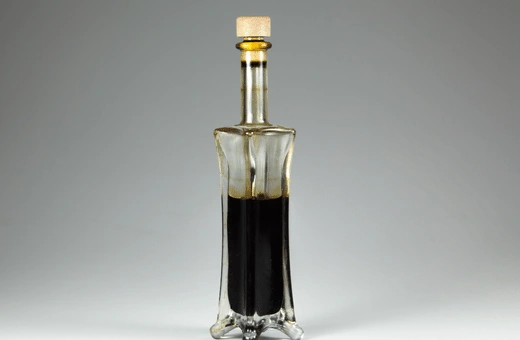You’re in the middle of cooking your favorite recipe, and you realize you don’t have enough tarragon vinegar to finish it.
What do you do? If you’re like most home cooks, you go searching for a substitute.
It can be tricky to know which alternative will work best when it comes to replacing an ingredient–especially one with a unique flavor profile like tarragon vinegar. But don’t worry; we’re here to help!
Let’s explore the best substitute for tarragon vinegar.
What is Tarragon Vinegar, AND What does tarragon vinegar taste like?
Tarragon vinegar is a popular condiment used in French cuisine. It is made from wine vinegar that has been infused with fresh tarragon leaves and spices such as cloves, bay leaves, and peppercorns.
The herb gives the vinegar its distinct flavor–buttery and slightly sweet, yet tangy with herbal notes.
As for what it tastes like – tarragon vinegar is tart up front that fades into a slight sweetness with a warm, herbal flavor reminiscent of licorice or anise.
It is especially delightful when drizzled on grilled shrimp and vegetables or used in
What is Tarragon Vinegar used for?
Tarragon vinegar is a versatile ingredient that can be used in a variety of dishes. It can be used to dress up salads, marinades, and sauces.
It also pairs well with fish and chicken dishes as it enhances their flavors without overpowering them.
Additionally, tarragon vinegar makes a great addition to many soups and stews, giving them a unique flavor.
Beyond cooking, tarragon vinegar can be used in homemade vinaigrettes or as a finishing touch for dishes such as grilled vegetables and roasted potatoes.
Due to its intense flavor, a little bit of tarragon vinegar goes a long way and can easily become the star of any dish.
Best Substitute for Tarragon Vinegar
1. Balsamic Vinegar
Balsamic vinegar makes a great substitute for tarragon vinegar, lending a dark, sweet taste that can be used in the same ways as its counterpart.
It’s versatile, making it possible to use Balsamic Vinegar for everything from flavoring salads and hot dishes to serving as an ingredient in marinades.

Compared to tarragon vinegar, Balsamic Vinegar also sports subtle undertones of molasses, figs, and raisins that provide different layers of flavor.
All it takes is a quick switch in recipes to take advantage of the deliciousness that Balsamic Vinegar can bring to any meal or occasion.
2. Champagne vinegar
Many people use tarragon vinegar as a seasoning and condiment, but since it can be hard to find and is quite expensive and it carries a distinct flavor without the heady herbiness of tarragon.
The bright, tart flavor of Champagne vinegar pairs well with delicate greens such as butter lettuce and milder greens like mache.
It can be used to make a delicate vinaigrette that can be topped with sprouts or small vegetables for an elegant but simple salad.
This light and mild vinegar can also provide an exciting tang to lighter dishes, such as Steamed Asparagus or pork tenderloin.
All in all, Champagne vinegar will not only provide a delicious alternative to tarragon vinegar but enjoys many of the same culinary applications.
3. Red Wine Vinegar
When looking to add a unique flavor to a dish, tarragon vinegar is often the perfect choice. However, if you find yourself without any on hand, red wine vinegar can make an excellent substitute.
The two kinds of vinegar share similar acidic notes, with the only difference being that red wine vinegar provides more of a full-bodied and dark fruit flavor.
Red wine vinegar also offers more versatility in cooking as it can be paired well with other ingredients such as herbs and seasonings like oregano, basil, black pepper, and cumin.
This makes Red Wine Vinegar perfect for use in a wide variety of recipes, from salads to marinades.
Furthermore, its distinct taste pairs well with herbs such as garlic or oregano that are used to season any dish.
So if you have a recipe that demands tarragon vinegar but don’t have any on hand, use red wine vinegar instead – your food will still come out tasting amazing!
4. White Wine Vinegar
White Wine Vinegar is a great substitute ingredient when tarragon vinegar is not available. It has a mild and delicate flavor that can easily be incorporated into any dish without overpowering the other flavors and tastes.
White wine vinegar also adds slight notes of acidity, which provide a nice balance to any dish.
A great thing about white wine vinegar is its versatility; it works in both sweet and savory dishes, making it a handy swap for tarragon vinegar in any recipe.
5. Malt Vinegar
Malt vinegar is often seen as an ideal substitute for tarragon vinegar because of its distinct flavor.
Although it has a subtle, sweet taste like tarragon, malt vinegar is milder and less bitter, which gives it a unique taste that can be used to enhance the flavor of dressings and sauces alike.
Its well-rounded taste adds necessary layers of flavor, with a subtle sweetness in comparison to tarragon vinegar’s tartness.
This balance makes Malt Vinegar an excellent option for numerous recipes, and it also contains fewer allergens than tarragon vinegar, making it better for those with food sensitivities or dietary restrictions.
Malt vinegar can also be used for cooking, adding a distinctive zing to dishes without the overpowering flavors associated with some other vinegar.
Best of all, malt vinegar is readily available in almost any grocery store!
6. Apple Cider Vinegar
Apple Cider Vinegar is an excellent replacement for tarragon vinegar in recipes. It’s milder than an assortment of other acidic ingredients, yet it still packs a flavor punch.
It has many health benefits, such as boosting digestion, aiding weight loss, and reducing inflammation.
Apple cider vinegar is often used to give a tangy finish to salads and marinades without overwhelming the original flavor of the dish.
For cooks looking for a healthier alternative to tarragon vinegar, Apple Cider Vinegar is an excellent choice that can help turn any recipe into something truly special!
7. ACP
ACP, or all-purpose condiment and pickling, is an ideal substitute for tarragon vinegar. It features a mild combination of vinegar and sugar that imparts both flavor and brightness to dishes.
Unlike other vinegar, ACP is much more versatile than tarragon vinegar and can be used in anything from salad dressings to marinades.
Additionally, it also provides a delightful hint of sweetness that mellows out the heavy acidity of other vinegar varietals.
Additionally, ACP has taken on an interesting place in cooking culture since its renowned popularity in Asia.
Whether you’re using it as a substitute for tarragon vinegar or looking to spice up your own unique dishes, ACP is truly a kitchen staple that should not be overlooked!
8. Rice Vinegar
Rice Vinegar offers a unique flavor that makes it an ideal substitute for tarragon vinegar. Its subtle sweetness serves as a perfect balance to the overall acidity of salads, dressings, and other dishes.
In addition to offering a similar acid profile, Rice Vinegar adds an interesting texture to food items.
It works wonderfully in marinades, glazes, and Asian-style stir-fries.
When substituting for tarragon vinegar, start by only using half of the amount called for in the recipe and then add more if needed for the desired flavor intensity.
Overall, Rice Vinegar is an excellent choice for its ability to add both flavor and texture to your recipes.
9. Sherry Vinegar
If you want to make a flavorful salad, sherry vinegar is a great substitute for tarragon vinegar.
Originally from Spain, sherry vinegar is created by fermenting sherry wine, and its deep flavor adds a unique yet complex dimension to your dishes.
Its smoky-sweet flavor also makes it an excellent ingredient for sauces and soups.

While it may not have the distinct herbaceous aroma of tarragon vinegar, its intensely nutty and sweet notes pair wonderfully with roasted vegetables, fish, or grilled meats for a gourmet meal.
10. Most Easy Lemon Juice- Best Non-Vinegar Tarragon Substitute
If you’ve ever needed a substitute for tarragon vinegar, lemon juice can be a perfect solution.
Not only does it add an acidic, bright flavor to dishes, but it also brings about a natural sweetness that omits the need to add additional calories or sweeteners.
You can use lemon juice as a salad dressing or steam vegetables and fish, producing a mouthwatering experience that your family and friends won’t soon forget.
Plus, you’ll get the added bonus of not needing to spend extra money on specialty vinegar. Bon appétit!
11. Fruit Vinegar
Fruit vinegar is an excellent substitute for tarragon vinegar and adds a unique flavor to any dish. It can be made from virtually any fruit, such as apples, oranges, grapes, and berries.
The resulting flavor will depend on the type of fruit used, but generally, it will have a much sweeter taste than tarragon vinegar.
The richness of the fruit vinegar is more mellow than tarragon vinegar but still provides a pleasing zing of acidity.
Furthermore, it’s also gluten-free, which makes it suitable for those with dietary needs. A good tip for making fruit vinegar is to always choose ripe fruits since underripe ones tend to have an unpleasant acidic flavor.
The process of making fruit vinegar is remarkably simple; just dissolve one part sugar and two parts white wine or cider vinegar in water and stir in chopped-up pieces of your favorite fruits!
This delightful concoction can be used in salads, marinades, dressings, or even desserts; truly, the possibilities are endless.
The most popular fruit vinegar, such as apple cider, raspberry, and sherry, can be used to dress salads, marinate meats, or even as a base in sauces.
All of these qualities make it a delicious and versatile substitute for tarragon vinegar.
Other Tarragon Vinegar Alternatives You can use in a Pinch
· Dried Tarragon leaves
· Dill extract
How to Make Tarragon Vinegar at Home?– Easy Homemade Tarragon Vinegar recipe
Making tarragon vinegar at home is a very simple process. All you need to do is find fresh, high-quality tarragon, chop it up into small pieces and place it in a jar with white vinegar.
Allow the mixture to sit for two weeks before straining out the tarragon bits. The longer you allow the mixture to be steep, the more flavorful your vinegar will be.
Now that you’ve created flavored vinegar, there are a variety of ways to use it in cooking. Tarragon vinegar has a unique flavor that pairs well with many types of vegetables and proteins.
Try drizzling some over-roasted brussel sprouts, mixed greens, or a baked fish filet for added flavor. It can also be used as the base of a vinaigrette salad dressing.
Tarragon vinegar is also great for pickling vegetables.
To make pickles with your homemade tarragon vinegar, simply mix it with some sugar, salt, and spices and pour it over your vegetables of choice.
Let the mixture sit for at least two days before consumption. Not only will your pickles be delicious, but they’ll also have a unique tangy flavor that comes from the tarragon vinegar.
FAQs on substitute for tarragon vinegar
Q1. What is the same as tarragon vinegar?
Tarragon vinegar is unique in its flavor, but there are a few kinds of vinegar that have similar flavors and characteristics. White wine vinegar, sherry vinegar, and Champagne vinegar all have mild acidic notes that pair well with the licorice-like flavor of tarragon.
Balsamic or raspberry vinegar also offers slight sweetness that can be used to mimic some of the qualities of tarragon vinegar. Additionally, herbs such as rosemary, basil, and thyme can also be used to enhance dishes in a similar way. Experiment with different kinds of vinegar and herbs for a flavor that suits your taste!
When using substitutes for tarragon vinegar, it is important to remember that a small amount of the substitute can go a long way in creating flavor complexity. Just as it is with tarragon vinegar, adding too much of a substitute can cause an overwhelming or unpleasant flavor. Start small and add more as desired.
Overall, tarragon vinegar offers a unique flavor and aroma qualities that are hard to replicate with other vinegar. However, there are substitutes that can be used to create a similar flavor profile in dishes. White wine vinegar, sherry vinegar, and Champagne vinegar all provide mild acidic notes, while balsamic or raspberry vinegar offer sweetness.
Additionally, herbs such as rosemary, basil, and thyme can also be used to enhance dishes in a similar way. Experimentation is key when it comes to finding the best substitute for tarragon vinegar!
Q2. Is tarragon vinegar the same as white wine vinegar?
No, tarragon vinegar is not the same as white wine vinegar. Tarragon vinegar has a slightly different flavor profile than white wine vinegar, with a hint of anise and licorice that comes from the tarragon leaves used to make it.
Tarragon vinegar also tends to have a milder acidity level than white wine vinegar, making it a great choice for salads and other dishes that require a lighter flavor. It is also used to make delicious sauces, marinades, and dressings.
White wine vinegar is usually made from white wines like chardonnay or sauvignon blanc and has a higher acidity level than tarragon vinegar.
It has a more robust flavor that can be used to add depth and complexity to dishes like soups, stews, and sauces. It is also a great choice for pickling vegetables or making vinaigrette dressings.
Both tarragon vinegar and white wine vinegar are great pantry staples to have on hand, so experiment with both to find the flavors you enjoy best!
Q3. What tastes similar to tarragon?
Other herbs and spices that are often compared to tarragon in terms of taste include anise, chervil, fennel, dill, marjoram, rosemary, oregano, and sage. Tarragon has a sinuous flavor with notes of licorice and grass. It is commonly used in French cooking and pairs well with fish, poultry, and other light meats.
It is also used to flavor vegetables, sauces, and salad dressings. Additionally, tarragon is a popular addition to vinegar-based salad dressings.
Other herbs and spices that are often used in place of tarragon include basil, cumin, coriander, parsley, thyme, and mint. These substitutions will change the flavor profile of a dish but can still produce tasty results.
Depending on the dish, any one of these herbs can be a great substitute for tarragon. Experimenting with different combinations and quantities is recommended to find the best flavor profile for your dish. However, tarragon remains the most distinctive way to impart a unique flavor to dishes that call for it.

